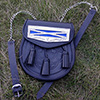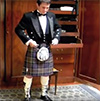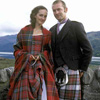Scotland
 A Scottish kilt is one of the most recognizable and well-known folk outfits around the world. There is so much info about Scottish traditional garments and, sadly, not all of it is true or at least fully accurate. In this post, we want to bust some of the widely-known myths about the kilt, tartan, and Scottish clothing traditions. Like how old a kilt really is? Or did every Scottish clan have their own tartan design?
A Scottish kilt is one of the most recognizable and well-known folk outfits around the world. There is so much info about Scottish traditional garments and, sadly, not all of it is true or at least fully accurate. In this post, we want to bust some of the widely-known myths about the kilt, tartan, and Scottish clothing traditions. Like how old a kilt really is? Or did every Scottish clan have their own tartan design?
- Details
- Category: Scotland
- Hits: 6032
 Scotland of one of those countries that preserve their old traditions very carefully and thoroughly. The locals love their folk clothing and often use it, especially for such special occasions as weddings, funerals, official events, large national holidays, etc. Besides, Scots have a serious number of local folk museums where everybody can see Scottish traditional attire. Here’s a list of such museums.
Scotland of one of those countries that preserve their old traditions very carefully and thoroughly. The locals love their folk clothing and often use it, especially for such special occasions as weddings, funerals, official events, large national holidays, etc. Besides, Scots have a serious number of local folk museums where everybody can see Scottish traditional attire. Here’s a list of such museums.
- Details
- Category: Scotland
- Hits: 5465
 The Scottish tartan is a classic example of traditional weave. Very often, the tartan for kilts, arisaids, belted plaids, and other Scottish garments is woven on handlooms instead of industrial computerized looms even in our days. It is a not so easy task for a newbie to work with a traditional weaving loom, and also, there are some peculiarities of making a tartan pattern. So, this article is dedicated to hand-weaving and finishing a tartan cloth. And the advice is given by a specialist, a Scottish artisan with great experience.
The Scottish tartan is a classic example of traditional weave. Very often, the tartan for kilts, arisaids, belted plaids, and other Scottish garments is woven on handlooms instead of industrial computerized looms even in our days. It is a not so easy task for a newbie to work with a traditional weaving loom, and also, there are some peculiarities of making a tartan pattern. So, this article is dedicated to hand-weaving and finishing a tartan cloth. And the advice is given by a specialist, a Scottish artisan with great experience.
- Details
- Category: Scotland
- Hits: 31866
 And it’s time for a new piece of info dedicated to the stage costumes of a popular series “Outlander”. This article will tell you about the historically accurate – and not really – female outfits used in this movie. Including stage costumes of such characters as Geillis Duncan, Jenny Murray, Laoghaire MacKenzie, Mrs. Fitzgibbons, and Letitia MacKenzie. Some of their attires are masterpieces, others are just plain awful. Also, you’ll find out some stuff about the 18th-century Scottish women’s clothing in general.
And it’s time for a new piece of info dedicated to the stage costumes of a popular series “Outlander”. This article will tell you about the historically accurate – and not really – female outfits used in this movie. Including stage costumes of such characters as Geillis Duncan, Jenny Murray, Laoghaire MacKenzie, Mrs. Fitzgibbons, and Letitia MacKenzie. Some of their attires are masterpieces, others are just plain awful. Also, you’ll find out some stuff about the 18th-century Scottish women’s clothing in general.
- Details
- Category: Scotland
- Hits: 33510
 We’re continuing our series of articles dedicated to the costumes of a popular TV show “Outlander”. Today, we’ll talk about the male outfits from Season 1. These are the costumes of the following characters: Dougal MacKenzie, Colum McKenzie, Murtagh Fraser, Ned Gowan, Angus Mhor and Rupert MacKenzie, Ian Murray, Taran MacQuarrie, and Hugh Munro. Many of their stage outfits are rather historically accurate and look just perfect. So, let’s take a closer look at the details of these fine Scottish garments.
We’re continuing our series of articles dedicated to the costumes of a popular TV show “Outlander”. Today, we’ll talk about the male outfits from Season 1. These are the costumes of the following characters: Dougal MacKenzie, Colum McKenzie, Murtagh Fraser, Ned Gowan, Angus Mhor and Rupert MacKenzie, Ian Murray, Taran MacQuarrie, and Hugh Munro. Many of their stage outfits are rather historically accurate and look just perfect. So, let’s take a closer look at the details of these fine Scottish garments.
- Details
- Category: Scotland
- Hits: 144648
 Most people who’ve ever seen a movie about Scotland (like “Outlander” or “Braveheart” or “Rob Roy”) noticed the outstanding local garment called the “great kilt” or “belted plaid”. It is a large piece of plain or tartan fabric, wrapped around the man’s body, and belted to keep it in place. But what do you really know about this outfit? It is so simple and so complicated at the same time. There are several different ways of wearing the plaid, depending on the weather, your needs, and the situation.
Most people who’ve ever seen a movie about Scotland (like “Outlander” or “Braveheart” or “Rob Roy”) noticed the outstanding local garment called the “great kilt” or “belted plaid”. It is a large piece of plain or tartan fabric, wrapped around the man’s body, and belted to keep it in place. But what do you really know about this outfit? It is so simple and so complicated at the same time. There are several different ways of wearing the plaid, depending on the weather, your needs, and the situation.
- Details
- Category: Scotland
- Hits: 23619
 We’ve already published one article about Claire Fraser’s stage outfits (you can read it here). But one material is way not enough to show all of her marvelous Scottish costumes filmed in the “Outlander” movie, in Season 1. So, we’ve made another one. You’ll be able to see many Claire’s tartan attires, her striking wedding dress (and find out what gown has inspired the costume designer on creating it), her diverse underpinnings, and even a men’s costume on her. We will reveal some secrets of making Claire’s costumes and also difficulties that the wardrobe team had.
We’ve already published one article about Claire Fraser’s stage outfits (you can read it here). But one material is way not enough to show all of her marvelous Scottish costumes filmed in the “Outlander” movie, in Season 1. So, we’ve made another one. You’ll be able to see many Claire’s tartan attires, her striking wedding dress (and find out what gown has inspired the costume designer on creating it), her diverse underpinnings, and even a men’s costume on her. We will reveal some secrets of making Claire’s costumes and also difficulties that the wardrobe team had.
- Details
- Category: Scotland
- Hits: 32435
 This character of Outlander had a pretty large number of gorgeous Scottish clothing pieces. Though, historically, it isn’t accurate because most of the people in the 18th-century Scotland had only 1 or 2 sets of clothes at one time (and even during their adult life). But due to such a diverse assortment of Claire Fraser’s stage costumes, we can find out a lot about the clothing traditions of Scotland, local clothing crafts, and fashionable designs in the mid-1700s. In this article, we will look at Claire's costumes from Season 1.
This character of Outlander had a pretty large number of gorgeous Scottish clothing pieces. Though, historically, it isn’t accurate because most of the people in the 18th-century Scotland had only 1 or 2 sets of clothes at one time (and even during their adult life). But due to such a diverse assortment of Claire Fraser’s stage costumes, we can find out a lot about the clothing traditions of Scotland, local clothing crafts, and fashionable designs in the mid-1700s. In this article, we will look at Claire's costumes from Season 1.
- Details
- Category: Scotland
- Hits: 39894
 This is the next article of the stage costumes series. This time, we’ll talk about the movie “Outlander” and Scottish traditional costumes used in it (at least in the first season of this serial). Folk clothing experts gave their opinion on how accurate the stage costumes of “Outlander” are. Also, we will find out what we should know about that historical period – the 18th century – and how the clothing articles for this show were created. First of all, let’s discuss the general info about the Outlander tartans.
This is the next article of the stage costumes series. This time, we’ll talk about the movie “Outlander” and Scottish traditional costumes used in it (at least in the first season of this serial). Folk clothing experts gave their opinion on how accurate the stage costumes of “Outlander” are. Also, we will find out what we should know about that historical period – the 18th century – and how the clothing articles for this show were created. First of all, let’s discuss the general info about the Outlander tartans.
- Details
- Category: Scotland
- Hits: 55235
 Most people know that the national garment in Scotland is a kilt, a wrap-around skirt-like outfit. Or at least, you must have heard the name. But what did Scottish people wear before the kilt? Actually, there was a very popular attire worn in this country for hundreds and hundreds of years. It was a belted plaid. This unique garment didn’t have a single stitch in it – it was held together with a belt and a knot and nothing else.
Most people know that the national garment in Scotland is a kilt, a wrap-around skirt-like outfit. Or at least, you must have heard the name. But what did Scottish people wear before the kilt? Actually, there was a very popular attire worn in this country for hundreds and hundreds of years. It was a belted plaid. This unique garment didn’t have a single stitch in it – it was held together with a belt and a knot and nothing else.
- Details
- Category: Scotland
- Hits: 13965
 The Scottish climate is rather harsh – cold, windy, and very changeable. That’s partially why the traditional clothing of this country is so unique. For centuries, Scots preferred woolen blankets that they wore draped around the body in various ways. Such tartan plaid was a unisex garment that kept people warm. One of the clothing articles made from a wrapped-around woolen blanket is the arisaid – female sort of a cloak for the upper body. And here is how to wear the arisaid.
The Scottish climate is rather harsh – cold, windy, and very changeable. That’s partially why the traditional clothing of this country is so unique. For centuries, Scots preferred woolen blankets that they wore draped around the body in various ways. Such tartan plaid was a unisex garment that kept people warm. One of the clothing articles made from a wrapped-around woolen blanket is the arisaid – female sort of a cloak for the upper body. And here is how to wear the arisaid.
- Details
- Category: Scotland
- Hits: 107364
 The folk dress of Scotland is pretty popular and famous, so perhaps you already know something about it. But we might reveal new facts and details of it in this article. Or at least, we’d like to share the photos of some cute Scottish garments and accessories. The authentic clothing is always wonderful, and weird for the outsiders, and skillfully made, and just plain beautiful.
The folk dress of Scotland is pretty popular and famous, so perhaps you already know something about it. But we might reveal new facts and details of it in this article. Or at least, we’d like to share the photos of some cute Scottish garments and accessories. The authentic clothing is always wonderful, and weird for the outsiders, and skillfully made, and just plain beautiful.
- Details
- Category: Scotland
- Hits: 27889
 Weaving looms around the world are built on the same principle but they are slightly different in each country. It’s actually natural that the craft of weaving in Scotland differ from the one in Ukraine or in India. So, there are special tricks and secrets of using a traditional loom in each country. Here is a short tutorial on how to weave on a traditional Scottish weaving loom.
Weaving looms around the world are built on the same principle but they are slightly different in each country. It’s actually natural that the craft of weaving in Scotland differ from the one in Ukraine or in India. So, there are special tricks and secrets of using a traditional loom in each country. Here is a short tutorial on how to weave on a traditional Scottish weaving loom.
- Details
- Category: Scotland
- Hits: 17018
 Spinning is one of the oldest clothing crafts in the world. Centuries ago, people used to make clothes at home, and they sewed it from hand-made fabrics that they had to produce themselves. In different countries, the process and tools for spinning and weaving differ. Let’s talk about Scottish drop spindle and the local spinning technique. Interesting fact: the thick end of the oldest known spindles in Scotland often were shaped like an animal's paw pads. Cute, isn’t it?
Spinning is one of the oldest clothing crafts in the world. Centuries ago, people used to make clothes at home, and they sewed it from hand-made fabrics that they had to produce themselves. In different countries, the process and tools for spinning and weaving differ. Let’s talk about Scottish drop spindle and the local spinning technique. Interesting fact: the thick end of the oldest known spindles in Scotland often were shaped like an animal's paw pads. Cute, isn’t it?
- Details
- Category: Scotland
- Hits: 50524
 Scottish kilt and many folk accessories (caps, bags, shawls, etc.) in Scotland are made from special tartan fabric. Historically, tartan is handmade – it was woven on weaving looms. Today, it is mostly industrially produced. But in this article, we’ll talk about a place where you can order any amount of tartan, even the fabric for a single kilt or a “patch” of unique tartan design. The fabric here is only half-handmade because the looms are motorized, so the weavers don’t have to use foot pedals to weave. But still, a lot of work is made by hand and the weavers control the process thoroughly.
Scottish kilt and many folk accessories (caps, bags, shawls, etc.) in Scotland are made from special tartan fabric. Historically, tartan is handmade – it was woven on weaving looms. Today, it is mostly industrially produced. But in this article, we’ll talk about a place where you can order any amount of tartan, even the fabric for a single kilt or a “patch” of unique tartan design. The fabric here is only half-handmade because the looms are motorized, so the weavers don’t have to use foot pedals to weave. But still, a lot of work is made by hand and the weavers control the process thoroughly.
- Details
- Category: Scotland
- Hits: 8743
 Let’s find out how to put on the full formal Prince Charlie outfit. Dr. Nick Fiddes, the governor of the Scottish Tartans Authority, will kindly share a few personal tips and tricks with you. He will show you the order of choosing and wearing the garments, which he finds works best. You can really feel like a manly man in a properly worn highland outfit.
Let’s find out how to put on the full formal Prince Charlie outfit. Dr. Nick Fiddes, the governor of the Scottish Tartans Authority, will kindly share a few personal tips and tricks with you. He will show you the order of choosing and wearing the garments, which he finds works best. You can really feel like a manly man in a properly worn highland outfit.
- Details
- Category: Scotland
- Hits: 42029
 Traditional dress of Scotland, which is also called the highland dress, changes our understanding of men's costume. Women's outfit is more familiar to us unlike men's kilt. No matter what, Scottish national dress is interesting and extraordinary. And also it is rather hard to put on a kilt and all the accessories correctly, especially when to talk about the phillabeg style of a kilt. You'll need some practice and knowledge for that.
Traditional dress of Scotland, which is also called the highland dress, changes our understanding of men's costume. Women's outfit is more familiar to us unlike men's kilt. No matter what, Scottish national dress is interesting and extraordinary. And also it is rather hard to put on a kilt and all the accessories correctly, especially when to talk about the phillabeg style of a kilt. You'll need some practice and knowledge for that.
- Details
- Category: Scotland
- Hits: 384509

